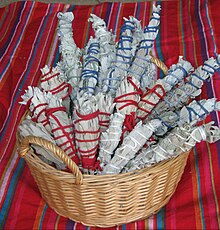Smudging
| Part of a series on |
| Indigenous rights |
|---|
| Rights |
| Governmental organizations |
| NGOs and political groups |
| Issues |
|
| Legal representation |
| Countries |
|
| Category |

Smudging, or other rites involving the burning of sacred herbs (e.g., white sage) or resins, is a ceremony practiced by some Indigenous peoples of the Americas. While it bears some resemblance to other ceremonies and rituals involving smoke (e.g., Australian smoking ceremony, some types of saining) from other world cultures, notably those that use smoke for spiritual cleansing or blessing, the purposes and particulars of the ceremonies, and the substances used, can vary widely among tribes, bands, and nations, and even more so among different world cultures. In traditional communities, Elders maintain the protocols around these ceremonies and provide culturally specific guidance.[1] The smudging ceremony, by various names, has been used by others outside of the Indigenous communities as part of New Age or commercial practices, which has also led to the over-harvesting of some of the plants used in ceremonies.[2] Indigenous people in the US and Canada have argued against appropriation and over-harvesting of white sage.[2][3][4]
Native American traditions
In some Indigenous American and Canadian ceremonies, certain herbs are traditionally used to purify or bless people and places.[1][5] For instance, some cultures use the smoke of burning red cedar as part of their particular purification and healing ceremonies.[6] Sometimes this is done in hospitals to "cleanse and repel evil influence."[7] However, the same herbs that are burned by one culture may be taboo to burn in another, or they may be used for a completely different purpose. When specific herbs are burned ceremonially, this may or may not be called "smudging", depending on the culture.[2] Traditionally, when gathering herbs for ceremonial use, care is taken to determine the time of day, month, or year when the herbs should be collected; for example, at dawn or evening, at certain phases of the moon, or according to yearly cycles. Gertrude Allen, a Lumbee, reported that her father, an expert in healing with plants, stated that sage varies in potency at different times of the year.[7]
While
While using various forms of
Controversy
While Californian
Some of the terminology in use among non-
Smudging "kits" are often sold commercially, by companies such as Anthropologie, Sephora, World Market, and Walmart, despite traditional prohibitions against the sale of spiritual medicines like white sage.[2][3][4] These may include bundles of a single herb or a combination of several different herbs; often these herbs are not found bundled together in traditional use, and their use is not universal to all, or even most, Native cultures.[2] In some Native American cultures the burning of these herbs is prohibited. Other commercial items may contain herbs not native to North America, or not indigenous to the region where they are being used, as well as substances that are toxic when burnt.[2]
[[Smudging is commonly used to ward off evil spirts or to cleans ones body, mind and soul.
Native American and First Nations students in college dorms have at times faced harassment and been forbidden from burning herbs for ceremonial reasons due to university fire prevention policies that prohibit the burning of candles or incense in college dorm rooms.[1] This has raised issues around the religious freedom of Native Americans.[9] In another account, a Native American in Cincinnati became ordained by the Universal Life Church in order to fulfill the requirement that only clergy members could perform smudging ceremonies as part of the prayer ritual for other Native Americans in area hospitals.[10]
Use of smoke in other cultures
Other cultures worldwide may burn herbs or incense for spiritual purposes, such as in smoking ceremonies, some forms of saining, or practices involving the use of incense censers. However, these cultures have their own practices, as well as their own beliefs about these ritual actions and the ritual use of smoke.[8]
See also
References
- ^ a b c d "Policy on preventing discrimination based on creed - Indigenous spiritual practices". Ontario Human Rights Commission. Retrieved March 26, 2021.
- ^ a b c d e f g h i j k Hay, Mark (1 April 2022). "In Southern California, the popularity of white sage threatens its survival - Unlike common sage, white sage grows in relatively few areas, which has led to poaching and illegal harvesting". atlasobscura. Retrieved 13 April 2022.
- ^ Albuquerque, NM: Red Earth Press. pp. 100–108.
- ^ S2CID 6012903.
- CTV.ca. Retrieved 2014-02-06.
- ISBN 0-393-31735-8.
- ^ a b Boughman, A. L., & Oxendine, L. O. (2003). Herbal remedies of the Lumbee Indians. Jefferson, N.C., McFarland.
- ^ a b c Guedon, Marie-Francoise (December 2000). "Sacred Smokes in Circumboreal Countries: An Ethnobotanical Exploration". The Northern Review. 22 (Winter 2000): 41–60. Retrieved 2020-06-18.
- ^ Stokes, DaShanne (May 18, 2001). "Sage, Sweetgrass, and the First Amendment". The Chronicle of Higher Education: B16.
- ^ Bishop, Lauren (April 14, 2007). "Ordained for the Occasion". The Cincinnati Enquirer. pp. A1, A9.
External links
- Elder furious Alberta department store selling sweetgrass - Video
- Sephora’s “Starter Witch Kit” and Spiritual Theft - Adrienne Keene (Cherokee) of Native Appropriations on commercial "smudge kits"
- Stokes, DaShanne. 2001. "Sage, Sweetgrass, and the First Amendment." The Chronicle of Higher Education, May 18, pp. B16.
